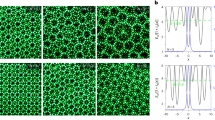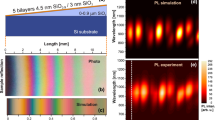Abstract
Quasicrystals1,2,3,4 are a class of lattices characterized by a lack of translational symmetry. Nevertheless, the points of the lattice are deterministically arranged, obeying rotational symmetry. Thus, we expect properties that are different from both crystals and glasses. Indeed, naturally occurring electronic quasicrystals (for example, AlPdMn metal alloys) show peculiar electronic, vibrational and physico-chemical properties. Regarding artificial quasicrystals for electromagnetic waves, three-dimensional (3D) structures have recently been realized at GHz frequencies5 and 2D structures have been reported for the near-infrared region6,7,8,9. Here, we report on the first fabrication and characterization of 3D quasicrystals for infrared frequencies. Using direct laser writing10,11 combined with a silicon inversion procedure12, we achieve high-quality silicon inverse icosahedral structures. Both polymeric and silicon quasicrystals are characterized by means of electron microscopy and visible-light Laue diffraction. The diffraction patterns of structures with a local five-fold real-space symmetry axis reveal a ten-fold symmetry as required by theory for 3D structures.
This is a preview of subscription content, access via your institution
Access options
Subscribe to this journal
Receive 12 print issues and online access
$259.00 per year
only $21.58 per issue
Buy this article
- Purchase on Springer Link
- Instant access to full article PDF
Prices may be subject to local taxes which are calculated during checkout




Similar content being viewed by others
References
Shechtman, D., Blech, I., Gratias, D. & Cahn, J. W. Metallic phase with long-range orientational order and no translational symmetry. Phys. Rev. Lett. 53, 1951–1953 (1984).
Levine, D. et al. Elasticity and dislocations in pentagonal and icosahedral quasicrystals. Phys. Rev. Lett. 54, 1520–1523 (1985).
Steinhardt, P. J. & Ostlund, S. The Physics of Quasicrystals (World Scientific, Singapore, 1987).
Janot, C. Quasicrystals (Clarendon, Oxford, 1992).
Man, W., Megens, M., Steinhardt, P. J. & Chaikin, P. M. Experimental measurement of the photonic properties of icosahedral quasicrystals. Nature 436, 993–996 (2005).
Zoorob, M. E., Charlton, M. D. B., Parker, G. J., Baumberg, J. J. & Netti, M. C. Complete photonic bandgaps in 12-fold symmetric quasicrystals. Nature 404, 740–743 (2000).
Kaliteevski, M. A. et al. Two-dimensional Penrose-tiled photonic quasicrystals: diffraction of light and fractal density of modes. J. Mod. Opt. 47, 1771–1778 (2000).
Kaliteevski, M. A. et al. Diffraction and transmission of light in low-refractive index Penrose-tiled photonic quasicrystals. J. Phys. Condens. Matter 13, 10459–10470 (2001).
Freedman, B. et al. Wave and defect dynamics in nonlinear photonic quasicrystals. Nature 440, 1166–1169 (2006).
Kawata, S., Sun, H.-B., Tanaka, T. & Takada, K. Finer features for functional microdevices. Nature 412, 697–698 (2001).
Deubel, M. et al. Direct laser writing of three-dimensional photonic-crystal templates for telecommunications. Nature Mater. 3, 444–447 (2004).
Tétreault, N. et al. New route to three-dimensional photonic bandgap materials: Silicon double inversion of polymer templates. Adv. Mater. 18, 457–460 (2006).
Roichman, Y. & Grier, D. G. Holographic assembly of quasicrystalline photonic heterostructures. Opt. Express 13, 5434–5439 (2005).
Deubel, M., Wegener, M., Linden, S., von Freymann, G. & John, S. 3D-2D-3D photonic crystal heterostructures fabricated by direct laser writing. Opt. Lett. 31, 805–807 (2006).
Li, F. H. & Wang, L. C. Analytical formulation of icosahedral quasi-crystal structures. J. Phys. C: Solid State Phys. 21, 495–503 (1988).
Koenderink, A. F., Lagendijk, A. & Vos, W. L. Optical extinction due to intrinsic structural variations of photonic crystals. Phys. Rev. B 72, 153102 (2005).
Acknowledgements
We acknowledge the support provided by the Deutsche Forschungsgemeinschaft (DFG) and the State of Baden-Württemberg through the DFG-Center for Functional Nanostructures (CFN) and by the European Union (EU) through contract number RII3-CT-2003-506350 (LENS) and NoE Phoremost (511616). The research of G.v.F. is further supported through a DFG Emmy-Noether fellowship. G.A.O. is Government of Canada Research Chair in Materials Chemistry. He is indebted to the Natural Sciences and Engineering Research Council of Canada for support of this research and the CFN for a Guest Professorship.
Author information
Authors and Affiliations
Corresponding author
Ethics declarations
Competing interests
The authors declare no competing financial interests.
Supplementary information
Supplementary Information
Supplementary figures S1 and S2 (PDF 62 kb)
Rights and permissions
About this article
Cite this article
Ledermann, A., Cademartiri, L., Hermatschweiler, M. et al. Three-dimensional silicon inverse photonic quasicrystals for infrared wavelengths. Nature Mater 5, 942–945 (2006). https://doi.org/10.1038/nmat1786
Received:
Accepted:
Published:
Issue Date:
DOI: https://doi.org/10.1038/nmat1786
This article is cited by
-
Quantum Walks in Periodic and Quasiperiodic Fibonacci Fibers
Scientific Reports (2020)
-
Intrinsic photonic wave localization in a three-dimensional icosahedral quasicrystal
Nature Physics (2017)
-
In-channel integration of designable microoptical devices using flat scaffold-supported femtosecond-laser microfabrication for coupling-free optofluidic cell counting
Light: Science & Applications (2015)
-
Bioinspired photonic structures by the reflector layer of firefly lantern for highly efficient chemiluminescence
Scientific Reports (2015)
-
Optics of photonic quasicrystals
Nature Photonics (2013)



